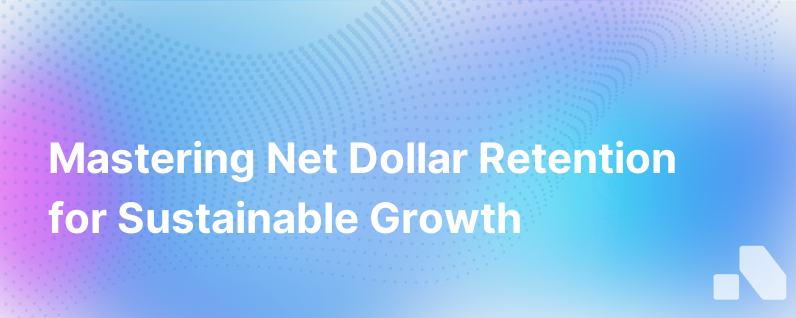What Is Net Dollar Retention And Why Is It Important
Published on October 11, 2023 by Sawyer Middeleer
Net Dollar Retention (NDR) has become the pulse by which Software as a Service (SaaS) companies gauge customer success, business health, and long-term profitability. Why? Because it encompasses the fundamental dynamics of a subscription model --not just customer retention, but revenue retention and expansion within your existing customer base.
In the realm of SaaS metrics, NDR is pivotal. It offers insights into customer satisfaction, product value, and loyalty, all of which funnel into predictable revenue streams—a golden ticket to achieving sustainable growth and investment attractiveness.
Understanding Net Dollar Retention
Before we dive into its importance, let's set the foundation: what is NDR?
Simply put, Net Dollar Retention measures the revenue retained from existing customers over a specific period considering churn, downgrades, and upsells. It's typically calculated annually and is expressed as a percentage. A Net Dollar Retention rate of over 100% indicates your business is growing from your existing customer base—even if no new customers were added during that period.
Here's how NDR is typically calculated:
-
Start with the revenue you had at the beginning of the period from existing customers (let’s call this Starting MRR - Monthly Recurring Revenue).
-
Deduct any revenue lost from churned customers during that period (Churned MRR).
-
Subtract any decreases in revenue due to downgrades (Downgraded MRR).
-
Add any increases in revenue due to expansions or upsells (Expansion MRR).
-
Your Net Dollar Retention is the ending MRR (from existing customers) divided by your Starting MRR, times 100 to get a percentage.
This straightforward formula encapsulates so much about a company's health. It's not just whether customers stick around—it's about the depth of their growth and engagement.
The Importance of Net Dollar Retention
Now, let’s explore the reasons why NDR is a critical metric.
Signal of Product Value
At its core, NDR is a reflection of your product’s value to your customers. High retention and expansion rates signal that customers are deriving significant benefits from your product or service. This is particularly crucial in the competitive SaaS sector, where alternative solutions are just a few clicks away.
Customer Satisfaction and Loyalty
NDR provides insights into customer satisfaction and loyalty, which are essential for the SaaS business model. When customers are happy with a service, they not only continue to subscribe, but they may also purchase additional features or higher-tiered plans, and they might recommend the product to others.
Indicator of Growth and Financial Health
Investors love NDR because it provides a crystal-clear indicator of a company’s organic growth and financial health. Even without new customer acquisition, an NDR above 100% indicates the company’s revenue is growing due to upsells and cross-sells. High NDR rates can therefore translate into higher company valuations.
Impacts Customer Acquisition Cost Payback
Customer Retention Cost (CAC) is another vital metric for SaaS companies. NDR affects the CAC payback period because the more a customer expands their spending, the quicker you recoup acquisition costs. This improves your return on investment for marketing and sales efforts.
Predictable Revenue Streams
A strong NDR signifies predictable revenue, which enables better forecasting and planning for businesses. It also reduces reliance on continuously acquiring new customers to maintain revenue, which can be a more volatile and expensive process.
Efficiency in Operations
Operational efficiency is improved when you can rely on existing customers to grow your revenue. It is generally more cost-effective to upsell an existing customer than to acquire a new one, thereby increasing the lifetime value (LTV) of the customer and improving overall margins.
Competitive Advantage
Lastly, NDR can be a significant competitive advantage. It reflects a scalable business model and healthy customer relationships, which are crucial for long-term success. Companies with high NDR rates can also invest more aggressively in growth, knowing they have a solid base of expanding recurring revenue.
Maximizing Net Dollar Retention
Understanding the importance of NDR natually leads to the question: how can businesses improve it? Key strategies include:
-
Customer Success Initiatives: Invest in customer success to ensure clients are achieving their goals with your solution.
-
Product Excellence: Continually improve your product based on customer feedback to increase satisfaction and opportunities for expansion.
-
Upsell and Cross-Sell Strategies: Develop targeted strategies for upselling and cross-selling that add genuine value to the customer experience.
-
Customer Feedback Loops: Implement customer feedback loops to identify issues early and to keep your services aligned with customer needs.
-
Churn Reduction Efforts: Analyze why customers are leaving and address those reasons proactively.
Net Dollar Retention is not just another metric—it's a comprehensive measure of a SaaS company's success in creating value for its customers, ensuring their satisfaction, and building a foundation for sustainable expansion. Companies that prioritize and excel in their NDR efforts tend to enjoy greater stability, higher valuations, and unlock the potential for exponential growth. In the burgeoning landscape of subscription-based business models, NDR represents the embodiment of customer-centric and growth-oriented operations.
In today's fast-paced SaaS environment, boosting your NDR is more crucial than ever. Adopting platforms that aid strategic account management and customer engagement, like Aomni, can help streamline these critical customer satisfaction and retention processes. With the right approaches and technologies in place, businesses can position themselves quite favorably for robust, customer-led growth.